Citations and references
Citations
- ↑ Gilbert, L. A. (1966). "Considen, Dennis ( - 1815)". Australian Dictionary of Biography . National Centre of Biography, Australian National University. ISSN 1833-7538 . Retrieved 28 October 2008.
- ↑ Copy of letter received by Dr Anthony Hamilton, from Dennis Considen, 18 November 1788, and sent onto Joseph Banks. Archived 25 July 2008 at the Wayback Machine
- ↑ Mackern, H.H.G., Research into the volatile oils of the Australian flora, 1788-1967. In: A Century of Scientific Progress, pp. 310–331. Centenary Vol., Royal Society of New South wales. Science Society House, Sydney, 1968.
- ↑ Small, B.E.J., "Assessing the Australian Eucalyptus oil industry". Forest and Timber, 13, pp. 13–16, 1977.
- ↑ Maiden, J.H., The Forest Flora of New South Wales, vol. 4, Government Printer, Sydney, 1922.
- ↑ Lassak, E.V., & McCarthy, T., Australian Medicinal Plants, Methuen Australia, 1983, p. 15, ISBN 0-454-00438-9.
- ↑ White, J., Journal of a Voyage to New South Wales, 1790
- ↑ Edinburgh Medical and Surgical Journal: Exhibiting A Concise View of the Latest and Most Important Discoveries in Medicine, Surgery, and Pharmacy, Volume Twentieth, 1824.
- ↑ Maiden, Joseph (1904). "On four new species of Eucalyptus". Proceedings of the Linnean Society of New South Wales. 29 (3): 475–478. doi:10.5962/bhl.part.20168 . Retrieved 9 May 2019.
Related Research Articles
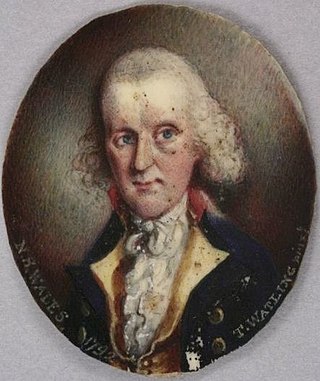
John White was an Irish surgeon and botanical collector.
D'Arcy Wentworth was an Irish-Australian surgeon and the first paying passenger to arrive in the new colony of New South Wales. He served under the first seven governors of the Colony, and from 1810 to 1821, he was "great assistant" to Governor Lachlan Macquarie. Wentworth led a campaign for the rights and recognition of emancipists and for trial by jury.

William Redfern was an English-raised surgeon in early colonial Australia who was transported to New South Wales as a convict for his role in the mutiny on the Nore. He is widely regarded as the "father of Australian medicine".
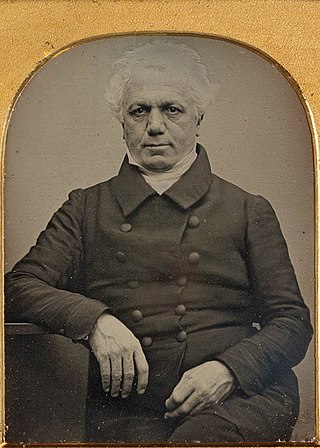
William Bland was a prominent public figure in the colony of New South Wales. A surgeon by profession, he arrived in Australia as a convict but played an important role in the early years of Australian healthcare, education and science.

Eucalyptus oil is the generic name for distilled oil from the leaf of Eucalyptus, a genus of the plant family Myrtaceae native to Australia and cultivated worldwide. Eucalyptus oil has a history of wide application, as a pharmaceutical, antiseptic, repellent, flavouring, fragrance and industrial uses. The leaves of selected Eucalyptus species are steam distilled to extract eucalyptus oil.
Henry George Smith was an Australian chemist whose pioneering work on the chemistry of the essential oils of the Australian flora achieved worldwide recognition.
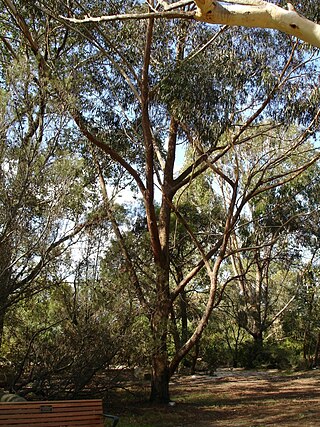
Eucalyptus piperita, commonly known as Sydney peppermint and urn-fruited peppermint, is a small to medium forest tree native to New South Wales, Australia.
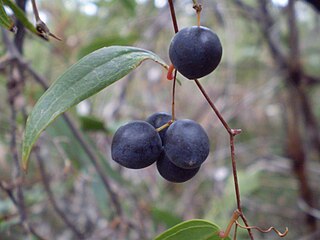
Smilax glyciphylla, the sweet sarsaparilla, is a dioecious climber native to eastern Australia. It is widespread in rainforest, sclerophyll forest and woodland; mainly in coastal regions.
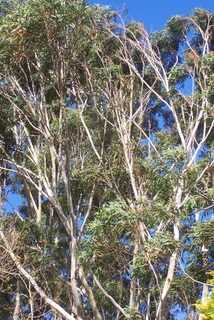
Eucalyptus pilularis, commonly known as blackbutt, is a species of medium-sized to tall tree that is endemic to eastern Australia. It has rough, finely fibrous greyish bark on the lower half of the trunk, smooth white, grey or cream-coloured bark above, lance-shaped to curved adult leaves, flower buds in groups of between seven and fifteen, white flowers and hemispherical or shortened spherical fruit.
Eucalyptus oreades, commonly known as the Blue Mountains ash, white ash or smooth-barked mountain ash, is a species of medium-sized to tall tree that is native to eastern Australia. It has smooth, powdery whitish bark with rough bark near the base, lance-shaped to curved adult leaves, flower buds in groups of seven, white flowers and cup-shaped to cylindrical fruit.

Eucalyptus deanei, commonly known as mountain blue gum, round-leaved gum, or Deane's gum, is a species of large tree endemic to New South Wales. It has smooth bark, lance-shaped leaves that are paler on the lower surface, flower buds in groups of seven to eleven, white flowers and cup-shaped to bell-shaped fruit.
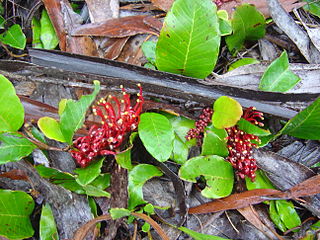
Grevillea laurifolia, commonly known as laurel-leaf grevillea, is a species of flowering plant in the family Proteaceae and is endemic to New South Wales. It is a prostrate, trailing shrub with egg-shaped, heart-shaped or round leaves, and clusters of reddish to deep maroon flowers.

Coronidium scorpioides, commonly known as the button everlasting, is a perennial herbaceous shrub in the family Asteraceae found in Australia. Previously known as Helichrysum scorpioides, it was placed in the newly described genus Coronidium in 2008.

Eucalyptus benthamii, commonly known as Camden white gum, Bentham's gum, Nepean River gum, kayer-ro or durrum-by-ang, is a species of tree that is endemic to New South Wales. It has mostly smooth bluish grey or white bark, lance-shaped to curved adult leaves, flower buds arranged in groups of seven, white flowers and cup-shaped, bell-shaped or conical fruit.

Persoonia myrtilloides, commonly known as myrtle geebung, is a plant in the family Proteaceae and is endemic to New South Wales. It is an erect to spreading shrub with elliptic to egg-shaped leaves and yellow flowers in groups of up to forty on a rachis up to 170 mm (6.7 in) long.
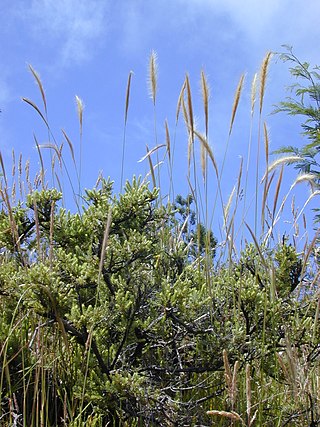
Dichelachne crinita , commonly known as the longhair plume grass, is a type of grass found in Australia, New Zealand and islands of the Pacific Ocean. It is often seen on sandy soils near the sea as well as woodlands. The flowering panicles are open and feathery at maturity. The grass may grow up to 1.5 metres (5 ft) tall. Crinita, the specific epithet, is derived from Latin (hairy).
Joseph Wilfrid Dwyer DD (1869–1939) was an Australian Catholic priest and Bishop of Wagga Wagga, New South Wales.

Eucalyptus consideniana, commonly known as yertchuk, is a species of plant in the myrtle family and is endemic to south-eastern Australia. It is a tree with rough, fibrous, sometimes prickly bark on the trunk and larger branches, smooth grey bark above, lance-shaped or curved adult leaves, flower buds in groups of between eleven and nineteen, white flowers and conical to hemispherical fruit.
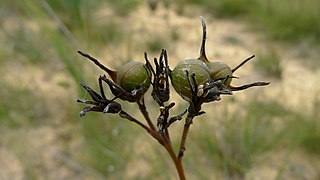
Haemodorum corymbosum, commonly known as the rush-leaf bloodroot, is a shrub native to southeastern Australia. Danish-Norwegian naturalist Martin Vahl described this species in his 1805 work Enumeratio Plantarum.
D'Arcy Wentworth, born Dorset Crowley, was a New South Wales army captain, police magistrate and politician.
References
- Historical Records of New South Wales, vol 1 part 2, vol 2.
- Historical Records of Australia , Series I, vol 1.
- Maiden, J.H., "Records of Australian Botanists: Considen, Denis" (sic), Journal and Proceedings of the Royal Society of New South Wales, vol 42, 1908, pp. 98–99.
- MacPherson, J., "Dennis Considen, Assistant Surgeon of the First Fleet", Medical Journal of Australia, 3 Dec 1927, pp. 770–73.
- Manuscript catalogue under Dennis Considen (State Library of New South Wales).